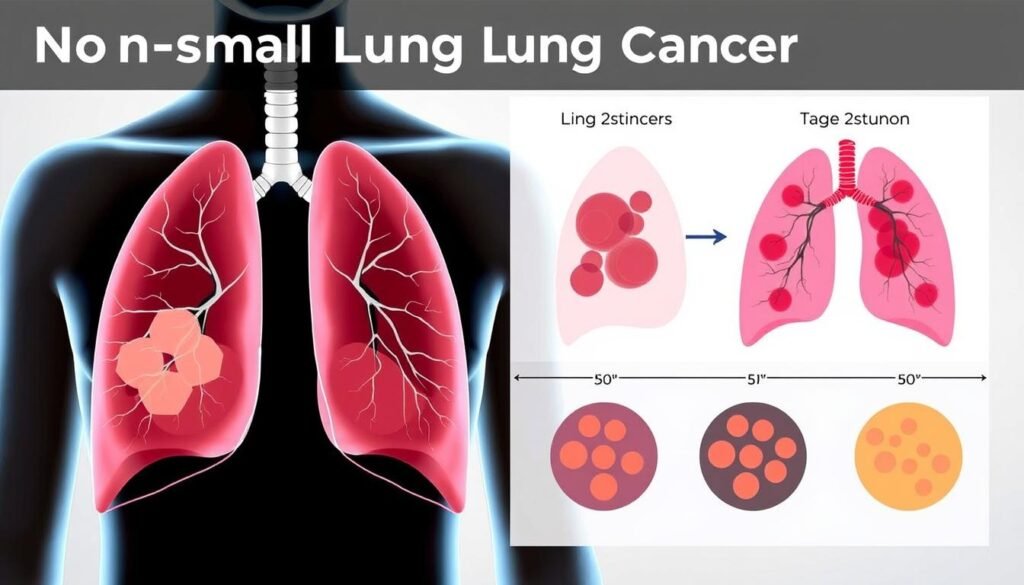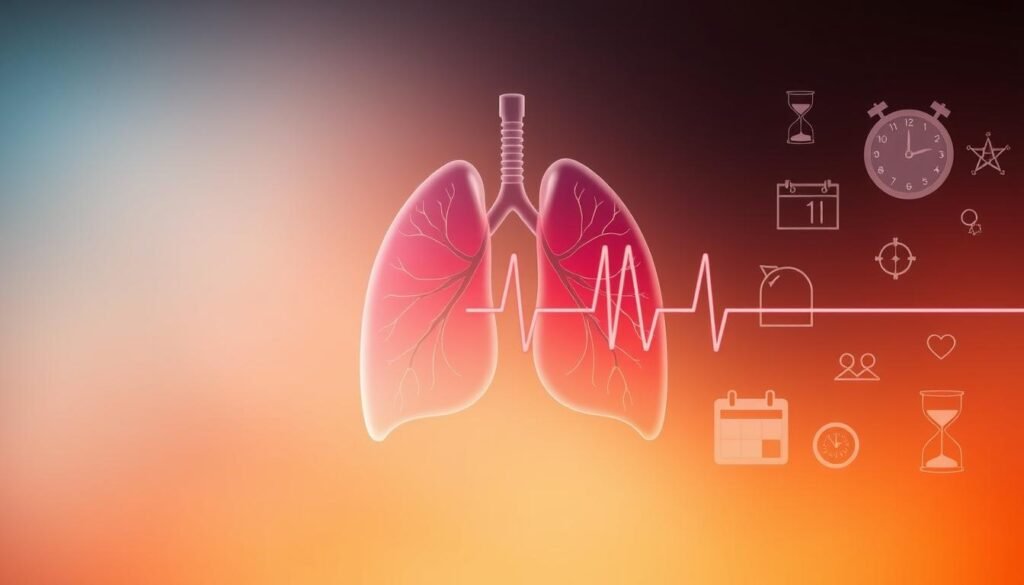In 2020, lung cancer caused an astounding 1.80 million cancer deaths worldwide. It was the number one cancer killer. For someone with stage 4 lung cancer, these numbers become very real. Knowledge of the stage 4 lung cancer prognosis is key. It affects both the patient and their family deeply. Sadly, only 5% survive more than five years after diagnosis.
Stage 4 lung cancer means the disease has spread to other body parts. This leads to various complicated symptoms. Patients and their families often go through hard emotional times. They need plenty of support and to understand what’s coming.
Key Takeaways
- In 2020, lung cancer was the leading cause of cancer deaths globally.
- The 5-year survival rate for stage 4 lung cancer is around 5%.
- Patients diagnosed with stage 4 cancer need to prepare for a challenging emotional journey.
- Understanding the prognosis is essential for making informed decisions.
- Support from family and resources can greatly impact patient wellbeing.
Understanding Stage 4 Lung Cancer
Stage 4 lung cancer is the most advanced stage. It means the cancer has spread beyond the lungs to other body parts. This spread, or metastasis, makes the disease more complex to treat. It also affects the patient’s outlook significantly.
At this stage, treatment becomes more aggressive but survival rates drop. For example, people with non-small cell lung cancer (NSCLC) have about a 9% chance of living five more years. Small cell lung cancer (SCLC) patients have an even lower chance, at 3%. These numbers show why catching lung cancer early is essential, though it’s often diagnosed late.
The type of lung cancer someone has can affect their prognosis. Adenocarcinoma patients usually do better than those with squamous cell carcinoma. New treatments, especially for certain genetic mutations, offer hope for better outcomes.
Palliative care is key for stage 4 patients. It aims to ease symptoms and improve life quality, not to cure the cancer. This care helps patients and their families face the challenges of advanced lung cancer. They can make more informed decisions about treatments and changes in their lives.
| Characteristic | NSCLC (Stage 4) | SCLC (Stage 4) |
|---|---|---|
| 5-Year Relative Survival Rate | 9% | 3% |
| Treatment Options | Targeted therapy, immunotherapy, chemotherapy | Chemotherapy with immunotherapy |
| Palliative Care | Essential for quality of life | Focus on symptom relief |
Understanding stage 4 lung cancer deeply helps in making treatment decisions. It also encourages better health management and builds support networks for patients and their families.
Symptoms of Stage 4 Lung Cancer
Knowing the symptoms of stage 4 lung cancer is key to managing it well. As the cancer gets worse, people may notice different signs. These hint at their health’s condition. Some people have ongoing lung cancer signs, while others see symptoms of cancer spreading to other body parts.
Persistent Symptoms
Those with stage 4 lung cancer often deal with continuous symptoms. These include:
- Worsening persistent cough that lingers
- Shortness of breath due to fluid around the lungs
- Fatigue that gets worse over time
- Chest pain caused by tumor growth or pressure in the chest
- Hemoptysis, or coughing up blood, showing the disease is advanced
Understanding these stage 4 lung cancer symptoms helps doctors and patients make better treatment choices. It also guides them in noticing health changes.
Metastatic Symptoms
As lung cancer gets worse, it often spreads to other body parts. This leads to more symptoms. Patients might experience:
- Intense headaches if cancer reaches the brain
- Jaundice, a sign of liver problems
- Weak limbs and problems moving if it spreads to bones
- Swollen lymph nodes visible in different body areas
Noticing these metastatic symptoms is key for evaluating how far the cancer has spread. It also helps in picking treatments to reduce discomfort. Knowing all the symptoms well helps patients and doctors talk better, leading to improved care.
| Persistent Symptoms | Metastatic Symptoms |
|---|---|
| Worsening persistent cough | Severe headaches |
| Shortness of breath | Jaundice |
| Fatigue | Weak limbs |
| Chest pain | Swollen lymph nodes |
| Hemoptysis |
Lung Cancer Types and Their Staging
Lung cancer has two main kinds: non-small cell lung cancer (NSCLC) and small cell lung cancer (SCLC). Knowing the differences between these types and their stages is key. This knowledge helps in choosing treatments and predicting outcomes.
Non-Small Cell Lung Cancer (NSCLC)
NSCLC is the most common lung cancer, making up 80-85% of cases. It’s staged by looking at tumor size, lymph node involvement, and if it has spread. The later stages, 4A and 4B, mean the cancer has moved beyond the lungs.
Stage 4A cancer has reached other body parts like the liver or bones. Stage 4B might have spread to several organs. The survival chances vary greatly. Only about 9% survive five years after being diagnosed with distant-stage NSCLC. This shows how serious late-stage cancer is.
Small Cell Lung Cancer (SCLC)
SCLC makes up 10-15% of lung cancers. It grows and spreads quickly. There are two main stages: limited and extensive. The extensive stage is similar to stage 4, posing a great challenge.
The prognosis for SCLC is grim, especially in its extensive stage. Only 3% survive five years, showing how aggressive SCLC is. Early catching and treating it can lead to better outcomes, contrasting with a 30% survival rate in localized cases.

| Type of Lung Cancer | Stage | 5-Year Relative Survival Rate |
|---|---|---|
| Non-Small Cell Lung Cancer (NSCLC) | Localized | 65% |
| Non-Small Cell Lung Cancer (NSCLC) | Regional | 37% |
| Non-Small Cell Lung Cancer (NSCLC) | Distant | 9% |
| Small Cell Lung Cancer (SCLC) | Localized | 30% |
| Small Cell Lung Cancer (SCLC) | Regional | 18% |
| Small Cell Lung Cancer (SCLC) | Distant | 3% |
Knowing about lung cancer types and stages helps doctors plan treatments. It also lets patients make informed choices about their care.
Stage 4 Lung Cancer Prognosis: What to Expect
Getting the news of stage 4 lung cancer can be very hard. It’s important to know what the stage 4 lung cancer prognosis means. This helps in making this difficult time a bit easier to handle. Survival rates for this stage are lower than for earlier stages. According to the American Cancer Society, only 9% of people with non-small cell lung cancer (NSCLC) survive five years after diagnosis.
The chance of living for one year after a stage 4 lung cancer diagnosis is between 15% and 19%. People with cancer that has spread far (metastatic lung cancer) have different survival times. This depends on the extent of the spread. For example, those with certain types of spread may live about 11.4 months. Others might only live around 6.3 months.
How old you are and whether you are a man or woman can change your outlook too. People younger than 50 have a five-year survival rate of 14.2%. But this drops to 5.6% for those 65 and over. Women also tend to do slightly better than men, with a survival rate of 8.6% compared to 5.6%.
Dealing with the emotional part of a stage 4 lung cancer prognosis is tough. There are many challenges, like figuring out treatments and handling the stress that comes with the statistics. Knowing about these issues can help in talking about care and getting support.
Remember, survival rates are just averages. How you do can vary a lot. This depends on your overall health, the kind of cancer, and how well treatments work. New treatments are always being developed. This brings hope for better results in the future.
Lung Cancer Survival Rates
Lung cancer survival rates are key in understanding what to expect after a diagnosis. They vary a lot depending on the cancer type and its stage when found. Knowing these rates is crucial for figuring out lung cancer life expectancy and planning treatments.
Five-Year Relative Survival Rate
From 2013 to 2019, the five-year survival rate for lung cancer was about 25.4%. This figure came from the National Cancer Institute’s SEER Program. The chance of survival changes a lot based on how far the cancer has spread. For early-stage lung cancer, the five-year rate is around 62.8%. But, it drops to about 8% once the cancer has spread far.
Stage 4 lung cancer survival rate is about 7%. For widespread small cell lung cancer, it’s even lower at 3%. These numbers show why finding and treating lung cancer early is vital.
Factors Affecting Survival Rates
Many things can influence how long someone with lung cancer might live. Age, sex, and overall health are big factors. Genetic changes can affect what treatments might work. How well treatments like chemo, radiation, or targeted therapies work also matters. Because each person is different, predicting exact survival rates is hard.
Understanding lung cancer survival rates and what influences them helps in making treatment decisions. It also helps patients and their families decide how they want to live. For more info, check out this deeply researched article.

Treatment Options for Advanced Lung Cancer
Knowing the different ways to treat advanced lung cancer is key for patients and their families. The treatment chosen often depends on the cancer’s type and stage and what the patient needs. Options like surgery, radiation, chemotherapy, and immunotherapy each play a big role. They help in controlling the disease and making life better.
Surgery and Radiation Therapy
Surgery and radiation can really help people with advanced lung cancer, depending on their situation. If the cancer has spread to places like the adrenal gland or brain, surgery might be an option if the patient is healthy enough. Radiation therapy can also help a lot. It can ease symptoms like pain or blockages caused by the cancer growing.
Systemic Treatments: Chemotherapy and Immunotherapy
Chemotherapy and immunotherapy are key in fighting advanced lung cancer. If the cancer hasn’t changed genetically, chemotherapy might be used. Common treatments combine drugs like cisplatin with gemcitabine. Immunotherapy works by targeting the tumor’s specific traits, especially when there’s a lot of the PD-L1 protein. There are also targeted treatments like erlotinib for certain genetic markers, which can lead to better results. New drugs and treatments for specific mutations are always being developed.
Palliative Care Options
Palliative care for lung cancer is all about making life better for people with advanced illness. It helps manage symptoms, like draining fluid that builds up. This kind of care is there for patients throughout their journey, not just at the end. It’s different from hospice care, which is for the very end of life. Palliative care can be given along with treatments meant to cure or extend life. It provides support and resources with compassion. For more details on managing advanced lung cancer, check out this resource.

Coping with Stage 4 Lung Cancer Prognosis
Dealing with a stage 4 lung cancer diagnosis can be very hard, as feelings change between fear, anxiety, and hope. It’s crucial to have emotional support while facing these tough emotions. Help from professionals and the support from friends and family offer comfort.
Emotional and Psychological Support
People with stage 4 lung cancer often feel alone due to their special challenges. Finding and using resources for families is key for connection and understanding. Counseling can help with deep feelings of sadness or worry. Attending therapy sessions or group meetings allows people to share and strengthen their spirit.
Support Groups and Resources
Meeting others in similar situations can lessen the feeling of being alone. Support groups for lung cancer provide a place to exchange stories, advice, and support. CancerCare offers free groups and programs for people with lung cancer. For more help, contact the LUNGevity Lung Cancer Helpline at 844-360-LUNG for more emotional support.
The table below shows helpful resources for patients and their families:
| Resource | Description | Contact |
|---|---|---|
| CancerCare | Provides financial help and support groups for dealing with cancer. | 800-813-HOPE |
| LUNGevity | This nonprofit focuses on resources and info for lung cancer. | Visit their website for more details |
| Magnolia Meals at Home | Sends healthy meals to families dealing with cancer. | Check their website for eligibility |
| Connect Education Workshops | Provides expert-led workshops on cancer topics. | Visit CancerCare’s site for schedules |
Outlook for Stage 4 Lung Cancer
The outlook for stage 4 lung cancer varies greatly because of many factors. Knowing these factors influencing prognosis helps patients and their families on this tough journey. The kind of lung cancer, the patient’s health, and available treatments are crucial for survival rates and life quality.
Factors Influencing Outlook
Statistics show a harsh truth: 60% to 70% of patients with non-small cell lung cancer (NSCLC) are found at a late stage. Only 7% of those with stage 4 NSCLC survive over five years. For those with extensive-stage small cell lung cancer (SCLC), the survival rate drops to 3%. These numbers underline the seriousness of the condition and the need for full understanding.
- Age plays a big role in prognosis, with older patients usually having worse outcomes.
- Genetic changes, like epidermal growth factor receptor (EGFR) mutations, affect how well treatments work and survival chances.
- Women may have better survival rates than men, studies show.
- Racial differences are clear. Black and Latino Americans often see lower survival rates because of problems with getting healthcare.
Making Informed Decisions
Making informed decisions for lung cancer treatment is key for patients and families. Good talks with doctors allow for better understanding of the choices. By going over personalized treatment plans, which might include chemotherapy, immunotherapy, and targeted therapies, patients can find what’s most suited to their health goals.
Joining support groups lets patients swap stories and advice, helping in making choices. Patient choices must focus on being comfortable, having a good quality of life, and thinking about palliative care for managing symptoms.
| Type of Lung Cancer | 5-Year Survival Rate | Average Life Expectancy (Months) |
|---|---|---|
| Non-Small Cell Lung Cancer (NSCLC) | 7% | 4-9 |
| Small Cell Lung Cancer (SCLC) | 3% | 8-13 |
Understanding stage 4 lung cancer’s effect and making informed choices offers a deeper knowledge of treatment options and aligning them with personal values. For more on survival rates and prognosis, visit this resource.
Conclusion
In summary, understanding stage 4 lung cancer is crucial for afflicted individuals and their loved ones. The five-year survival rate has improved to 28.4% due to better early detection and treatment. However, only 16.0% of those who could be screened were checked in 2022. This underscores the need for increased awareness and preventive actions.
Screening could lessen the mortality rate of lung cancer by up to 20%. It could also add 500,000 more years to lives and save significant money. Educating people about lung cancer risks and the importance of screenings is vital, especially for those at higher risk. This knowledge enables families to make informed health decisions and strengthens their support networks.
Staying informed about lung cancer prognosis is key. The ongoing improvement in treatments and the role of genetic factors like EGFR and KRAS mutations are transforming lung cancer care. Access to emotional and psychological support is also essential. Together with medical progress, this support brings hope and resilience to those on this journey.